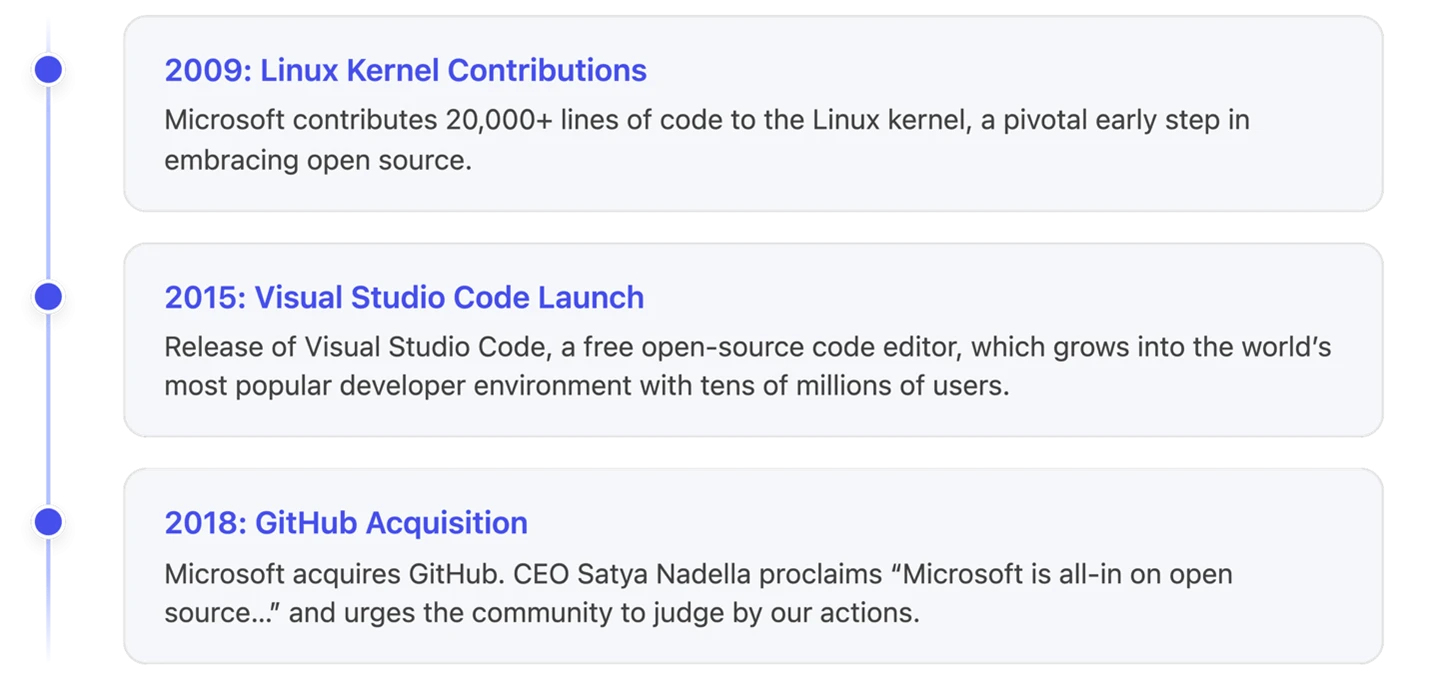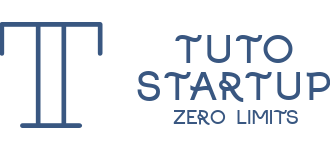
Microsoft’s open source journey: From 20,000 lines of Linux code to AI at global scale

Microsoft’s engagement with the open source community has transformed the company from a one-time skeptic to now being one of the world’s leading open source contributors… So, how did we get here? Let’s look at some milestones in our journey and explore how open-source technologies are at th…
Microsoft’s engagement with the open source community has transformed the company from a one-time skeptic to now being one of the world’s leading open source contributors. In fact, over the past three years, Microsoft Azure has been the largest public cloud contributor (and the second largest overall contributor) to the Cloud Native Computing Foundation (CNCF). So, how did we get here? Let’s look at some milestones in our journey and explore how open-source technologies are at the heart of the platforms powering many of Microsoft’s biggest products, like Microsoft 365, and massive-scale AI workloads, including OpenAI’s ChatGPT. Along the way, we have also introduced and contributed to several open-source projects inspired by our own experiences, contributing back to the community and accelerating innovation across the ecosystem.

Embracing open source: Key milestones in Microsoft’s journey
2009—A new leaf: 20,000 lines to Linux. In 2009, Microsoft contributed more than 20,000 lines of code to the Linux kernel, initially Hyper‑V drivers, under General Public License, version 2 (GPLv2). It wasn’t our first open source contribution, but it was a visible moment that signaled a change in how we build and collaborate. In 2011, Microsoft was in the top 5 companies contributing to Linux. Today, 66% of customer cores in Azure run Linux.
2015—Visual Studio code: An open source hit. In 2015, Microsoft released Visual Studio Code (VS Code), a lightweight, open-source, cross-platform code editor. Today, Visual Studio and VS Code together have more than 50 million monthly active developers, with VS Code itself widely regarded as the most popular development environment. We believe AI experiences can thrive by leveraging the open-source community, just as VS Code has successfully done over the past decade. With AI becoming an integral part of the modern coding experience, we’ve released the GitHub Copilot Chat extension as open source on GitHub.
2018—GitHub and the “all-in” commitment. In 2018, Microsoft acquired GitHub, the world’s largest developer community platform, which was already home to 28 million developers and 85 million code repositories. This acquisition underscored Microsoft’s transformation. As CEO Satya Nadella said in the announcement, “Microsoft is all-in on open source… When it comes to our commitment to open source, judge us by the actions we have taken in the recent past, our actions today, and in the future.” In the 2024 Octoverse, GitHub reported 518 million public or open-source projects, over 1 billion contributions in 2024, about 70,000 new public or open-source generative AI projects, and about a 59% year-over-year surge in contributions to generative AI projects.
Open source at enterprise scale: Powering the world’s most demanding workloads
Open-source technologies, like Kubenetes and PostgreSQL, have become foundational pillars of modern cloud-native infrastructure—Kubernetes is the second largest open-source project after Linux and now powers millions of containerized workloads globally, while PostgreSQL is one of the most widely adopted relational databases. Azure Kubernetes Service (AKS) and Azure’s managed Postgres take the best of these open-source innovations and elevate them into robust, enterprise-ready managed services. By abstracting away the operational complexity of provisioning, scaling, and securing these platforms, AKS and managed PostgreSQL lets organizations focus on building and innovating. The combination of open source flexibility with cloud-scale reliability allows services like Microsoft 365 and OpenAI’s ChatGPT to operate at massive scale while staying highly performant.
COSMIC: Microsoft’s geo-scale, managed container platform powers Microsoft 365’s transition to containers on AKS. It runs millions of cores and is one of the largest AKS deployments in the world. COSMIC bakes in security, compliance, and resilience while embedding architectural and operational best practices into our internal services. The result: drastically reduced engineering effort, faster time-to-market, improved cost management, even while scaling to millions of monthly users around the world. COSMIC uses Azure and open-source technologies to operate at planet-wide scale: Kubernetes event-driven autoscaling (KEDA) for autoscaling, Prometheus, and Grafana for real-time telemetry and dashboards to name a few.
OpenAI’s ChatGPT: ChatGPT is built on Azure using AKS for container orchestration, Azure Blob Storage for user and AI-generated content, and Azure Cosmos DB for globally distributed data. The scale is staggering: ChatGPT has grown to almost 700 million weekly active users, making it the fastest-growing consumer app in history.1 And yet, OpenAI operates this service with a surprisingly small engineering team. As Microsoft’s Cloud and AI Group Executive Vice President Scott Guthrie highlighted at Microsoft Build in May, ChatGPT “needs to scale … across more than 10 million compute cores around the world,” …with approximately 12 engineers to manage all that infrastructure. How? By relying on managed platforms like AKS that combine enterprise capabilities with the best of open source innovation to do the heavy lifting of provisioning, scaling, and healing Kubernetes clusters across the globe.
Consider what happens when you chat with ChatGPT: Your prompt and conversation state are stored in an open-source database (Azure Database for PostgreSQL) so the AI can remember context. The model runs in containers across thousands of AKS nodes. Azure Cosmos DB then replicates data in milliseconds to the datacenter closest to the user, ensuring low latency. All of this is powered by open-source technologies under the hood and delivered as cloud services on Azure. The result: ChatGPT can handle “unprecedented” load—over one billion queries per day, without a hitch, and without needing a giant operations team.
What Azure teams are building in the open
At Microsoft, our commitment to building in the open runs deep, driven by engineers across Azure who actively shape the future of open-source infrastructure. Our teams don’t just use open-source technologies, they help build and evolve them.
Our open-source philosophy is straightforward: we contribute upstream first and then integrate those innovations into our downstream products. To support this, we play a pivotal role in upstream open-source projects, collaborating across the industry with partners, customers, and even competitors. Examples of projects we have built or contributed to include:
- Dapr (Distributed Application Runtime): A CNCF-graduated project launched by Microsoft in 2019, Dapr simplifies cloud-agnostic app development with modular building blocks for service invocation, state, messaging, and secrets.
- Radius: A CNCF Sandbox project that lets developers define application services and dependencies, while operators map them to resources across Azure, AWS, or private clouds—treating the app, not the cluster, as the unit of intent.
- Copacetic: A CNCF Sandbox tool that patches container images without full rebuilds, speeding up security fixes—originally built to secure Microsoft’s cloud images.
- Dalec: A declarative tool for building secure OS packages and containers, generating software bill of materials (SBOMs) and provenance attestations to produce minimal, reproducible base images.
- SBOM Tool: A command line interface (CLI) for generating SPDX-compliant SBOMs from source or builds—open-sourced by Microsoft to boost transparency and compliance.
- Drasi: A CNCF Sandbox project released in 2024, Drasi reacts to real-time data changes using a Cypher-like query language for change-driven workflows.
- Semantic Kernel and AutoGen: Open-source frameworks for building collaborative AI apps—Semantic Kernel orchestrates large language models (LLMs) and memory, while AutoGen enables multi-agent workflows.
- Phi-4 Mini: A compact 3.8 billion-parameter AI model released in 2025, optimized for reasoning and mathematics on edge devices; available on Hugging Face.
- Kubernetes AI Toolchain Operator (KAITO): A CNCF Sandbox Kubernetes operator that automates AI workload deployment—supporting LLMs, fine-tuning, and retrieval-augmented generation (RAG) across cloud and edge with AKS integration.
- KubeFleet: A CNCF Sandbox project for managing applications across multiple Kubernetes clusters. It offers smart scheduling, progressive deployments, and cloud-agnostic orchestration.
This is just a small sampling of some of the open-source projects that Microsoft is involved in—each one sharing, in code, the lessons we’ve learned from running systems at a global scale and inviting the community to build alongside us.
Open Source + Azure = Empowering the next generation of innovation
Microsoft’s journey with open source has come a long way from that 20,000-line Linux patch in 2009. Today, open-source technologies are at the heart of many Azure solutions. And conversely, Microsoft’s contributions are helping drive many open-source projects forward—whether it’s commits to Kubernetes; new tools like KAITO, Dapr, and Radius; or research advancements like Semantic Kernel and Phi-4. Our engineers understand that the success of end user solutions like Microsoft 365 and ChatGPT rely on scalable, resilient platforms like AKS—which in turn are built on and sustained by strong, vibrant open source communities.
Join us at Open Source Summit Europe 2025
As we continue to contribute to the open source community, we’re excited to be part of Open Source Summit Europe 2025, taking place August 25–27. You’ll find us at booth D3 with live demos, in-booth sessions covering a wide range of topics, and plenty of opportunities to connect with our Open Source team. Be sure to catch our conference sessions as well, where Microsoft experts will share insights, updates, and stories from our work across the open source ecosystem.
1 TechRepublic, ChatGPT’s On Track For 700M Weekly Users Milestone: OpenAI Goes Mainstream, August 5, 2025.
The post Microsoft’s open source journey: From 20,000 lines of Linux code to AI at global scale appeared first on Microsoft Azure Blog.
Author: Ryan Waite
